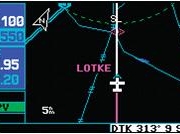Remember your first landing? Like – EVER? I do.
It was not really a magic moment I should say. More like a… very down to earth thing. (I couldn’t resist!) But jokes appart, the one thing I remember about that day was how meticulously my flight instructor checked the weather, winds, etc. to insure a perfect day for the first landing of my life as a pilot. Then as time passed and we advanced in the curriculum, we started actually looking for windy days, allowing us to practice and perfect the mystical crosswind techniques, or even just learning to land short or on a given/chosen target.
The reality is though, on any given day you go flying for work, it’s very rare to have no wind at all or a wind favoring a runway 100%. Add to this snow, darkness, icy runway or any other negative factors like this, and you quickly see your workload increase dramaticly during the most critical phase of your flight. I’m sure that you have already seen a similar figure, but just for conversation’s sake, let’s have a quick peak at it:
Source: Statistical Summary of Commercial Jet Airplane Accidents, 1959 - 2008, Boeing
A quick glance at those statistics clearly illustrates one clear truth about flying: Quit landing, it could kill you! What? You don’t agree? Fair enough. Let’s see how we can avoid the whole dying part then! As mentioned previously, there are many factors which relate to a successful (or unsuccessful) landing. Knowing them and being able to recognize the danger zones will help you make sure that every landing you make, is one that you can walk away from – and yes, with all the parts still attached to the airplane.
RFI/RFC/SCR
A big part of winter flying and something we learn early in flight school is to find, interpret and use a Runway Friction Index/Coefficient, or Surface Condition Report. But let’s say we are new at this. What exactly is a a RFI/RFC, and more importantly, what does it eat for breakfast?
”SCRs are issued to alert pilots of natural surface contaminants, such as snow, ice or slush that could affect aircraft braking performance. The RSC section of the report provides information describing the runway condition in plain language, while the CRFI section describes braking action quantitatively using the numerical format described in AIR 1.6.3.” – Source: Transport Canada AIM, October 2010
So in simple language, the SCR is a two-parts reports describing how slippery the runway is (RFI) and what makes it slippery (RSC). That’s great information to have handy, as well as to check every time you go away from base in the winter. If the report is old, make sure to call and obtain a new one as conditions can change rapidly in the winter.
So now we know what a SCR is. Great. How does it help us and how can we use it? First, let’s have a look at how it’s obtained. Having a bit of perspective is always good when doing decision making!
”Description of Canadian Runway Friction Index (CRFI) and Method of Measurement: The decelerometer is an instrument that is mounted in a test vehicle and measures the decelerating forces acting on the vehicle when the brakes are applied. The instrument is graduated in increments from 0 to 1, the top number being equivalent to the theoretical maximum decelerating capability of the vehicle on a dry surface. These numbers are referred to as the CRFI. It is evident that small numbers represent low braking coefficients of friction while numbers on the order of 0.8 and above indicate the braking coefficients to be expected on bare and dry runways. The brakes are applied on the test vehicle at 300-m (1000-ft) intervals along the runway within a distance of 10 m (30 ft) from each side of the runway centreline at that distance from the centreline where the majority of aircraft operations take place at each given site. The readings taken are averaged and reported as the CRFI number […]
[…] The format of the CRFI portion of the report is as follows: location indicator, title (CRFI), runway number, temperature in degrees Celsius, runway average CRFI reading, and time (UTC) when readings were taken using a ten-figure time group in the year-month-day-hour-minute (YYMMDDHHMM) format. ” – Source: Transport Canada AIM, October 2010
This description gives us two very important pieces of information:
1) How to interprete a CRFI. I was onced asked (by a captain no less!!!), while listening to the ATIS before going flying, if a low was good or high was good. Usual common sense would dictate that high is good when talking about breaking. But here it is in black and white. 1 = best, 0 = worst.
2) Note that the coefficient is only good for 10m (30ft) either side of the centerline. So next time you do a crosswind landing on a runway that’s very wide, don’t get complacement and work hard to remain on the center-line, where you are insured a given breaking coefficient. You know how it feels when you drive your car on a snowy road in the winter, and a tire gets caught in that layer of slush/heavy snow? The car starts pulling hard towards that side. The airplane will react exactly the same way if you get one of your main wheels in the un-treated part of the runway edge, and the wheel will act as a pivot point.
All this is great information to know. But where do you find it before you go flying? In Canada, it is found in the NOTAMs (NOtice To Air Men). If you are already in the air and going towards a destination with an ATIS/AWOS, the information will be relayed via those means as well. A NOTAM is distributed on the AFTN upon any of the following runway conditions:
- slush or wet snow on the runway;
- loose snow on the runway exceeding ¼ in. in depth;
- the runway is not cleared to the full width. When the runway is partially cleared, the report will also include a description of the uncleared portion of the runway (depth of snow, windrows, snowbanks, etc.);
- compacted snow, ice or frost on the runway; or
- the CRFI reading is 0.40 or less.
In NOTAMs, SCRs are found for both PAVED and GRAVEL runways. Here are two examples:
Examples of RSC and CRFI report for paved runways:
CYHZ RSC 05/23 160 FT CL 40 PERCENT COMPACTED SN 60 PERCENT FROST REMAINDER 80 PERCENT COMPACTED SN 20 PERCENT FROST. RMK: SANDED 100 FT CL. 1002131240
CYHZ CRFI 05/23 0 .22 1002131234CYHZ RSC 14/32 160 FT CL 20 PERCENT COMPACTED SN 80 PERCENT FROST REMAINDER 80 PERCENT COMPACTED SN 20 PERCENT FROST. RMK: SANDED 100 FT CL 1002131240
CYHZ CRFI 14/32 0 .29 1002131210Examples of RSC and CRFI report for gravel runways:
CYBK RSC 16/34 100 PERCENT 1/2 INS DRY SN ON COMPACTED SN 1012190640
CYBK CRFI 16/34 -22 .30 1012190645(Source: Transport Canada AIM, October 2010)
How does RFI and RSC affects Aircraft Performance, and how to deal with it.
There are two main performance aspects linked to the condition of a runway: Landing Distance, and Crosswind tolerance.
The first aspect, Landing Distance, is one often overlooked when planning a flight. It’s generally taken for granted that despite the greatly reduced breaking performance, the runway will still remain long enough to allow operations. However, ”assuming” should never be part of a pilot’s vocabulary. This is why Transport Canada and other agencies around the world established parameters and charts allowing a pilot to acquire a much more accurate picture concerning landing conditions.
First of all, let’s review Transport Canada’s description of the landing technique recommended when low RFIs are suspected or reported:
”The recommended landing distances […] are based on standard pilot techniques for the minimum distance landings from 50 ft, including a stabilized approach at Vref using a glideslope of three degrees to 50 ft or lower, a firm touchdown, minimum delay to nose lowering, minimum delay time to deployment of ground lift dump devices and application of brakes and discing and/or reverse thrust, and sustained maximum antiskid braking until stopped.” – Source: Transport Canada AIM, October 2010
*Note: It is a general concensus that use of reverse thurst during gravel operations is greatly discouraged to avoid propeller damage. Also note that the abusive use of breaking on runways full of snow/slush might lead to frozen brakes when the airplane is parked. Always adapt your landing technique to the actual conditions, needs of the flight safety and available resources and tools.
Now that we have a technique, what can we expect when it’s executed properly? As previously stated, there are two performance angles to check before commencing a flight.
Transport Canada has provided a performance table to which pilots can refer quikly to verify the landing performance of any given airplane under different runway surface conditions:
 Source: Transport Canada AIM, October 2010
Source: Transport Canada AIM, October 2010
*Note: The recommended landing distances in Table 2 take into account the reduction in landing distances obtained with the use of discing (beta) and/or reverse thrust capability for a turboprop-powered aeroplane and with the use of reverse thrust for a turbojet-powered aeroplane. If you are flying a piston powered airplane, refer to table 1 in the TC AIM for the correct table.
Knowing the landing distance, one can now plan accordingly. But – you may ask – what happens if the favoring runway for the wind is now too short due to low RFC? What if using the longer runway will also mean accepting a crosswind? Or what if there is only one runway and it’s somewhat slippery as well as under somewhat of a crosswind component? This is where the next chart comes in handy, allowing us to account for the Crosswind Tolerance (our second performance factor):
This chart provides information for calculating headwind and crosswind components and the vertical lines indicate the recommended maximum crosswind component for reported CRFI.
Example: CYOW CRFI 07/25 – 4C .30 1001191200 – Source: Transport Canada AIM, October 2010
Great stuff! Here is a quick recap of what we have talked about so far:
- What is a RSC/RFI/SCR
- How is it calculated, and what that means to the pilot
- Where to find it and how to read it
- How to use it and adjust our flying accordingly
As stated previously, a runway that is simply wet does not command a SCR. But a wet runway can still hide many hazards for pilots, as well as the conditions associated with it (thunderstorms, microbursts, etc). More importantly, a wet runway will most likely affect your landing performance, just as much as an icyor snowy runway could do.
In the next article, we will discuss hydroplanning, how it’s calculated, and what it means to pilots
******************************
For more information about RFI, RSC and SCR, please consult the Transport Canada Aeronautical Information Manual.
Also check out the following links for interesting articles:
Environmental and runway surface conditions during friction tests







[…] This post was mentioned on Twitter by Jean Denis Marcellin, Jean Denis Marcellin. Jean Denis Marcellin said: A landing you can walk away from – What to know about the most demanding phase of your flight (Part 1): http://wp.me/pC0AO-3q […]
[…] Part 1 of A landing you can walk away from – What to know about the most demanding phase of your flight – Runway Friction […]
[…] Part 1 of A landing you can walk away from – Runway Friction Index) (Read Part 2 of A landing you can walk away from – Runway Friction […]